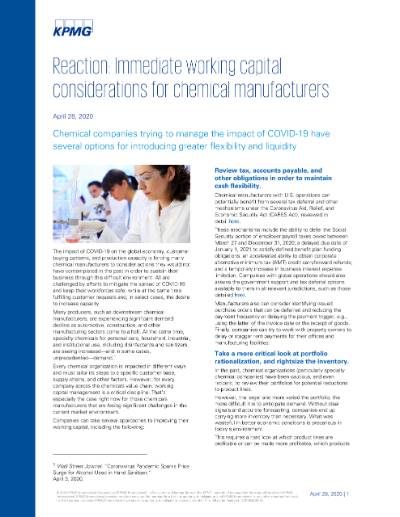The impact of COVID-19 on the global economy, customer buying patterns, and production capacity is forcing many chemical manufacturers to consider actions they would not have contemplated in the past in order to sustain their business through this difficult environment. All are challenged by efforts to mitigate the spread of COVID-19 and keep their workforces safe, while at the same time fulfilling customer requests and, in select cases, the desire to increase capacity.
Many producers, such as downstream chemical manufacturers, are experiencing significant demand decline as automotive, construction, and other manufacturing sectors come to a halt. At the same time, specialty chemicals for personal care, household, industrial, and institutional use, including disinfectants and sanitizers, are seeing increased—and in some cases, unprecedented—demand.1
Every chemical organization is impacted in different ways and must tailor its steps to a specific customer base, supply chains, and other factors. However, for every company across the chemicals value chain, working capital management is a critical discipline. That’s especially the case right now for those chemicals manufacturers that are facing significant challenges in the current market environment.
Companies can take several approaches to improving their working capital, including the following:
Review tax, accounts payable, and other obligations in order to maintain cash flexibility.
Chemical manufacturers with U.S. operations can potentially benefit from several tax deferral and other mechanisms under the Coronavirus Aid, Relief, and Economic Security Act (CARES Act), reviewed in detail here.
These mechanisms include the ability to defer the Social Security portion of employer payroll taxes owed between March 27 and December 31, 2020; a delayed due date of January 1, 2021 to satisfy defined benefit plan funding obligations; an accelerated ability to obtain corporate alternative minimum tax (AMT) credit carryforward refunds; and a temporary increase in business interest expense limitation. Companies with global operations should also assess the government support and tax deferral options available to them in all relevant jurisdictions, such as those detailed here.
Manufacturers also can consider identifying issued purchase orders that can be deferred and reducing the payment frequency or delaying the payment trigger, e.g., using the latter of the invoice date or the receipt of goods. Finally, companies can try to work with property owners to delay or stagger rent payments for their offices and manufacturing facilities.
Take a more critical look at portfolio rationalization, and rightsize the inventory.
In the past, chemical organizations (particularly specialty chemical companies) have been cautious, and even reticent, to review their portfolios for potential reductions to product lines.
However, the larger and more varied the portfolio, the more difficult it is to anticipate demand. Without clear signals and accurate forecasting, companies end up carrying more inventory than necessary. What was wasteful in better economic conditions is precarious in today’s environment.
This requires a hard look at which product lines are profitable or can be made more profitable, which productsshould continue to receive support because demand is expected to bounce back quickly, and which products should be shed outright.
For example, if some SKUs are not moving, do they play a strategic role in the portfolio, and can they be substituted? Or, if customers are trying to order out-of-stock products, can those be substituted with a slower-moving or obsolete item, thereby “trimming the fat” and freeing up cash? This rationalization exercise also is necessary for companies that are verging on bankruptcy and need to quickly determine the appropriate assets to shed.
Gathering the data doesn’t have to be complicated; demand signals are in plain sight. During these extraordinary times, when many customers across all industries are going to extremes—stockpiling on one end to walking away from products altogether on the other—a look inside warehouses will clearly indicate what customers think they can and can’t live without.
Collaborate and integrate with suppliers and customers to enhance long-term mutual resilience and success.
As chemical manufacturers rationalize their portfolios, it’s important to keep in mind the stress that their key suppliers and customers also are experiencing in these tough business conditions. This includes the oil and gas industry, reeling from demand destruction and a price war, and automotive companies forced to suspend manufacturing amidst an economic downturn and to protect employee health and safety.
In fact, there are certain suppliers that are extremely important in the value chain, making distinct products for specific customers, and their ability to stay in business could be threatened. It’s a tough balance to strike, and one that requires negotiation, innovative thinking, and new business models.
One opportunity chemical companies are using to help suppliers become more financially secure is a supplier financing program, leveraging third-party financial platforms or funds. These financing programs can help suppliers access cash when necessary without having to borrow, giving them the flexibility and backing to provide uninterrupted products and services to manufacturers.2 In the last few months, we’ve seen an uptick in the number of suppliers across multiple industries taking advantage of these programs and an increase in the amount of payment that suppliers are taking early, as opposed to waiting for cash based on their payment terms.
Companies should also identify customers and suppliers under severe financial stress to understand their viability once we move past the immediate challenges and prioritize cash collections from customers that are at the greatest risk, in addition to clearly understanding the potential impact if a supplier could no longer source materials for the company.
Plan a working capital management approach after we move past the immediate challenges.
Even without a clear view of the future, now is still the time to develop a plan for how the company is going to adjust cash flow and working capital management when COVID-19 restrictions are relaxed and customer demand begins to return or shift.
This includes identifying and preserving key strategic initiatives and ring-fencing funding where possible, so that these efforts can be reignited when the economy comes back. Cash should be managed not only to safeguard the organization in the present, but with a focus on protecting its future as well.
Even beyond the necessary review of working capital, the current challenge is an opportunity for chemical manufacturers to gain greater insight into their abilities to respond to business continuity and economic stresses, their service capabilities, and their customers’ behavior. As discussed, chemical manufacturers can take this moment to revisit buying patterns and determine which products are moving or growing in demand, and then reshape their portfolios for the post-COVID-19 environment. If it’s not moving right now, perhaps it shouldn’t be in the product lineup.
After the immediate public health challenge is addressed and the global economy enters into recovery, the difficulties chemical companies are experiencing today can lead to stronger businesses tomorrow if they can quickly adapt to address their own and their suppliers’ working capital needs.
KPMG Global Energy Institute
The KPMG Global Energy Institute (GEI) is a worldwide knowledge-sharing form on current and emerging industry issues. Launched in 2007, the GEI interacts with over 30,000 members through multiple media channels, including audio and video webcasts, publications and white papers, podcasts, events, and quarterly newsletters. Subscribe today to begin receiving valuable insights covering critical business topics and industry issues by visiting Global Energy Institute.




